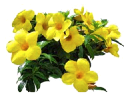Allamanda cathartica L
| Alamanda | |
| Saintific Name | Allamanda cathartica L. |
| Synonyms | A. hendersonii Bull., A. augustifolia Pohl, A. schottii |
| Family | Apocynaceae |
| Common Name | Golden trumpet vine, Yellow Bell (English), Huang ying (China) |
 |
{slider=Distribution|closed}
Native to South and Central America. Cultivated as Ornamental Garden plant.New plants are made from cuttings. A. carthatica is not randomly distributed but preponderantly found in strongly acidic soil and in specific areas of soil rich in iron, manganese and phosphorus, and in sandy loam soils (Ogbemudia F.O. , et al. 2013).
{/slider}
{slider=General Appeatance}
Perennial shrub. Sprawling shrub or woody climber, leaves whorled, glossy, lethery, flowers tubular, in clusters at ends of branches. Vigorous, smooth, slightly hairy shrub growing 2 to 4 meters high. Leaves are opposite, in whorls of 3 or 4, although the upper ones may be scattered, lanceolate or oblong-lanceolate, 8 to 12 centimeters long, 2.5 to 4 centimeters wide, pointed on both ends. Flowers are yellow and short-stalked.
{/slider}
{slider=Traditional Uses}
In Suriname’s traditional medicinec the roots are used against juandice, complication with malarian and enlarged spleen. The flowers act as a laxative and antibiotic against Staphyloccus spp, malaria and root used for juandice. In Trinidad, used for treating malaria and jaundice. In Guiana, the latex is used as a purgative and employed for colic. In Surinam, the plant is used as a cathartic (http://stuartxchange. com/Kampanilya.html). Leaves used as purgative or emetic in Southeast Asia. Leaves are also used as an antidote, and for relieving coughs and headaches.
{/slider}
{slider=Major Chemical Constituents}
Phytochemical studies revealed the main constituents to be alkaloids, flavonoids, saponins and carbohydrates. - Contains allamandin, a toxic iridoid lactone. - Study of phospholipid fatty acid composition yielded 7-Methyl-5,9-octadecadienoic acid.
{/slider}
{slider=Pharmacology}
• Wound Healing: The study of aqueous extract showed significant wound healing activity in wound models studies with decrease epithelizations time, high skin breaking strength, and increase in granulation tissue weight and hydroxyproline content. The Allamanda leaf extract possesses better wound healing activity than the Laurus nobilis. (Nayak S. et al, 2006).
• Reversible Antifertility Effect: The study on the oral administration of aqueous leaf extract of A.c showed reversible suppression of fertility in male mice – organ weight,, testosterone levels, sperm parameters among others – without detectable toxic effects (Singh A. & S.K. Singh 2008).
• Antidermatophytic: Plumeride, an active principle isolated from the leaves of A.c showed strong fungitoxicity against some dermatophytes causing dermatomycosis to both humans and animals (Tiwari T.N. et al 2002)
• Purgative Effect :Study showed the aqueous extract of leaves of A. c could produce a purgative effect by increasing intestinal motility, partly through muscarinic receptor activation.
• Anti-Proliferative/Cytotoxic: Study evaluated the anti-proliferative effect of A. blanchetti and A. schottii on K562 leukemic cells. Results showed both plants exhibited cytostatic and cytotoxic activity, the most active were located in the roots.
• Antimicrobial: Study of leaf extract of A. cathartic showed antimicrobial activity – the chloroform extract showed significant activity against Shigella dysenteriae, moderate activity against B subtilis, P aeruginosa and A. niger.
• Bioactive Iridoids / Cytotoxic: Study of ethanol extract of A cathartica and H fallax isolated a weakly cytotoxic isoplumericin and plumericin.
• Synergistic Anti-Inflammatory Activity: Study investigated the anti-inflammatory activity of a methanolic extract of A. cathartica and Piper nigrum in a carageenan-induced paw edema model. Results showed a synergistic interaction between A. cathartica and P. nigrum.
An aqueous extract of the leaves of A. cathartica was screened for gastrointestinal effects. The extract induced dose-related purgation in mice, as judged by an increased number of wet feces in the extract-treated rats. In addition, the extract enhanced the propulsive movement of intestinal contents. On the isolated ileum of guinea pig, the extract induced dose-related contractions that were insensitive to hexamethonium. mepyramine and methysergide, but were blocked by atropine. Phytochemical tests revealed the main constituents as alkaloids, flavonoids, saponins and carbohydrates. These findings suggest that the aqueous extract of the leaves of A. cathartica might elicit a purgative effect by increasing intestinal motility. partly via muscarinic receptor activation (Akah P.A & V.N. Offiah, 1992).
{/slider}
{slider=Toxicity Study}
Toxic only of large quantities eaten. Skin irritation minor, or lasting only a few minutes (Russsel A.B. et al 1997). A six year old who sucked on allamanda stems became nauseated. The next day he developed an itchy rash the next day. A women who got Allamanda sap in her eye reported a strong burning senstion. In small doses, allamanda leaves , stems anmd the flowers produce diarrhea, Larger amounts cause violent vomiting and diarrhea. Regularly drinking allamanda tea causes chronic diarrhea. Usually the neusea, vomitting, diarrhea and rash produced by this plant disappear without treatment (http://books.google.com.my/). Plumieride extracted with methanol by soxhlet extraction exhibited a noncytotoxic nature against P388 mouse leukimia cell line (Tiwari T.N. et al 2002).
{/slider}
{slider=References}
Akah P.A. & V. N. Offiah (1992). Gastrointestinal Effects of Allamanda cathartica Leaf Extracts. Pharmaceutical Biology; http://informahealthcare.com/doi/abs/10.3109/ 13880209209054001
Nayak S., P. Nalabothu, S. Sandiford, V. Bhogadi and A. Adogwa (2006). Evaluation of wound healing activity of Allamanda cathartica L and Laurus nobilis L. Extracts on rats. BMC Complementary and Alternative Madicine, 6; 12 , http://www.ncbi.nlm.nih.gov/ pmc/articles/PMC1456996.
Ogbemudia F.O,E. Ogie-Odia, O. Kekere (2013) Microhabitat Distribution of Allamanda Carthatica Linn and Pandiaka Involucrata (Moq) Jackson Octa Journal of Environmental Research Vol 1(2): 161-172.
Russell A.B. , J. W. Hardin, L. Grand, A. Fraser (1997). Poisonous Plants of North Carolina; http://www.ces.ncsu.edu/depts/hort/consumer/poison/Allamca.htm
http://books.google.com.my/Allamanda
http://www.fs.fed.us/global/iitf/pdf/shrubs/Allamanda%20cathartica.pdf
Philippine Medicinal Plants. http://stuartxchange.com/Kampanilya.html.
Tiwari T.N., V.B. Pandey V.B. and N.K. Dubey (2002). Plumieride from Allamanda Cathartica as an Antidermatophytic agent. Phytotherapy Research; 16, Pg. 393-394.http://informahealthcare.com/ doi/abs/10.3109/13880209209054001
Singh A. & K. Singh (2008). Reversible antifertility effect of aqueous leaf extract of Allamanda cathartica L. In male laboratory mice. Andrologia Vol 40 (6) http://onlinelibrary.wiley.com/ doi/10.1111/j.1439-0272.2008.00866.x/pdf.
{/slider}
- Last updated on .
- Hits: 5543
